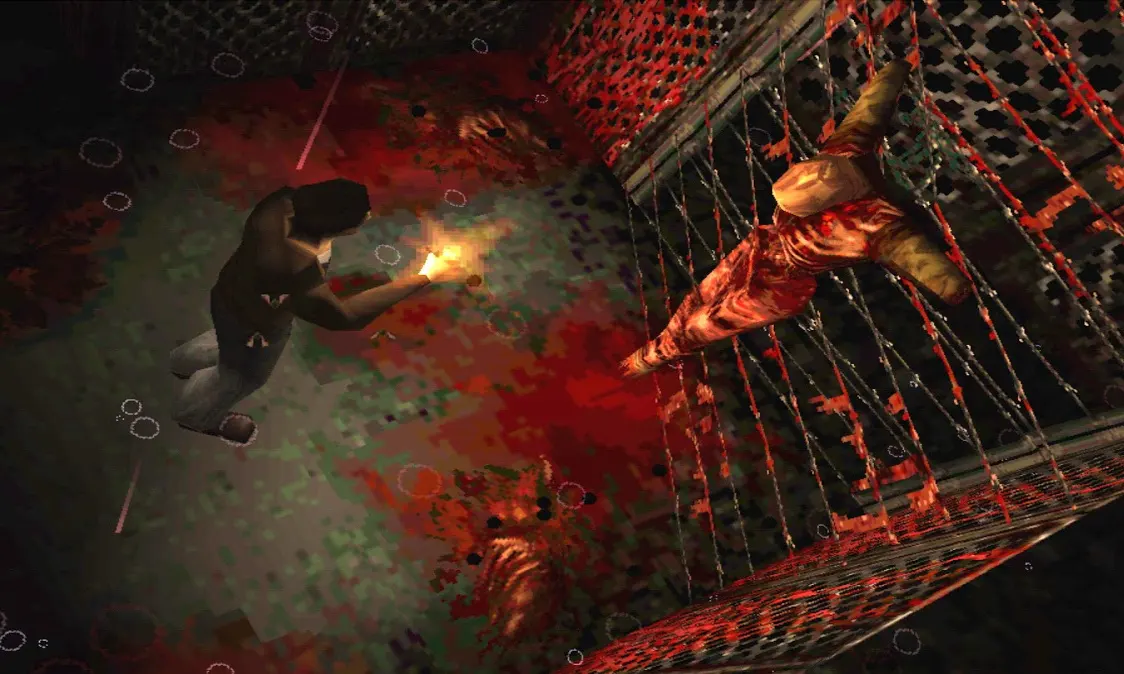This post contains minor spoilers for bosses, locations, and enemies in Silent Hill, though I talk very little about the plot and story. Silent Hill is a horror game and I provide some screenshots including low-detail blood and gore. Otherwise the discussion is light.
The upside to having played Dead By Daylight for over 300 hours is that I got familiar with a lot of franchises that I've experienced and liked, Silent Hill being a big one that I got sucked into recently. The first three games, which are what I have played as of writing this, are really effective at constant tension. The games rarely try to surprise you, as the presence of nearby terrors are almost always readily announced to you. What makes the first game work for me are the oppressive visuals and soundscape combined with the structure and information of each area.
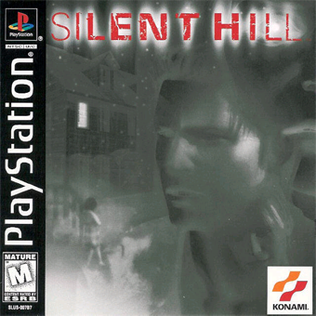
The fog is probably Silent Hills most well-known feature, the trivia of why it was in the first game being Did-You-Know-Gaming tier knowledge (it was hardware limitations, if you don't know.) What sets apart SH1's visibility situation apart from future titles is that it is never-changing. SH2 and SH3 mix it up with sparsely or dimly lit interiors, giving you some visibility of what is ahead of you. Whether it is foggy or simply too dark, SH1 never lets you see more than a few paces in front of you, making the environments feel oppressive to explore. Your best clue to the threats in your surroundings are the crackling of your radio and the distinct sounds of monsters nearby.
The terrors of Silent Hill 1 resemble fears a child might have. Fright over imposing animals are shown in bestial interpretations of dogs and birds of prey that chase you down on the streets. The basement is the most nerve-wracking part of any building, having distinct ambience that churns into a terrible overpowering chorus of machinery when you activate a generator or similar object. The basements had me the most worried that there was something in the room with me, with the cacophany constantly setting off false alarms. Certain locations reveal specific fears and angsts. The children in the hallways and classrooms of the school are ready to either gather to harm you or run in fear of you. The hospital is filled with nurses and doctors hunched over, as if constantly operating. The bosses are as if the child's fearful imagination ran away, forming ideas of what the monster is in the basement or if insects were large enough to eat you whole.
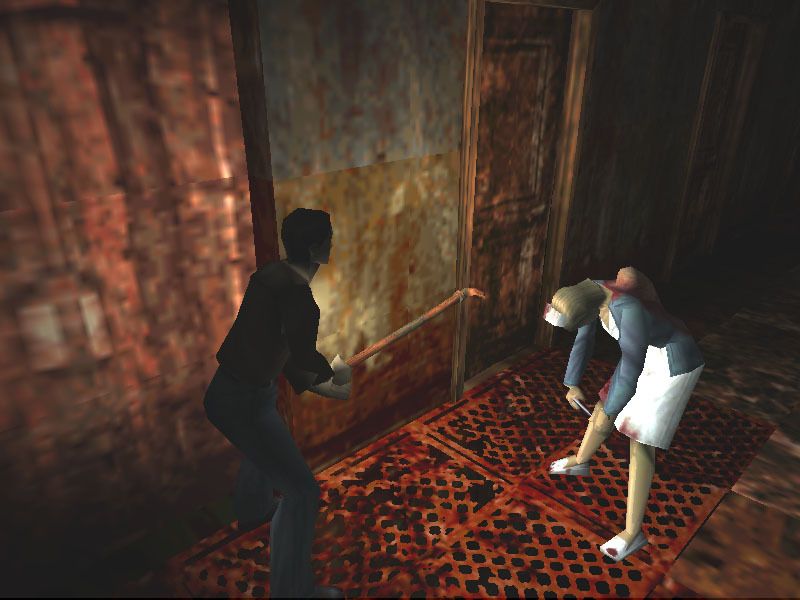
Awesome enemy btw
Silent Hill and its sequels were the most engaged I was navigating a space in a while. The games have an interesting map situation, in which you are given a seemingly complete map of the current area you are in partways into exploring it. You soon learn that all of these maps were only accurate before the mysterious disaster that has befallen Silent Hill, as the town is now filled with chasms in its roads, unopenable doors, leveled walls, and unpowered elevators. The map is now unreliable, details and changes have to be filled in as you decide on fight or flight. The protagonist, in this case Harry Mason, fills in these details themselves.
I found this not only a neat way to give and obfuscate information needed to navigate, but also made encounters with monsters more tense. Frantically trying doors could get me away from the current threat, but could also back me into a corner if they all ended up locked. Silent Hill's tendency to blockade also lets it take place in mundane spaces while also being interesting to navigate. Every space also gets a different spin in their Alternate versions, in which Silent Hill enters its full chain-linked imprisoned nightmare. Entering this space changes which doors, stairs, and other pathways are accessible. This drastically changes the shape of the space you are exploring, often going ways that would have seemed roundabout before. Previously shut-off rooms may now be enterable, albiet only viewable in its nightmarish state.
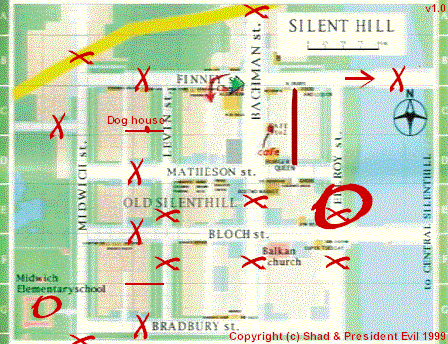
I would definitely like to play more titles with a neat map system like Silent Hill. I enjoy the incomplete but informative maps of games like Super Metroid and Silent Hill compared to overinformative maps like Symphony of the Night. Super Metroid gives you room shapes and locations but no information on the layouts of each room or how they connect, always leaving space for your mental map to fill in details. This gives navigation and backtracking some interest for me because the flow of an area isn't always as obvious as the map suggests. Silent Hill doesn't have much in terms of backtracking, except to return to unsolved puzzles, but I like the excitement the map gives to monster encounters and the satisfaction of a finished map. Symphony of the Night has a map that fills in every tile you explore and tells you exactly how everything connects, making the navigation of an already straight-foward world even more obvious.
The puzzles of Silent Hill are suitably cryptic feeling and gives the feeling that this nightmare world was waiting for someone like Harry. The difficulty setting in the sequels refer to them as "riddles" which feels apt even if puzzle feels like a more correct term. I had fun interpretting poems or figuring out the association between images and objects. It felt like solving something more loose and open rather than rigid, which helps solutions not feel immediately obvious even if the puzzle isn't very hard (though I did have a lot of trouble with some of them).
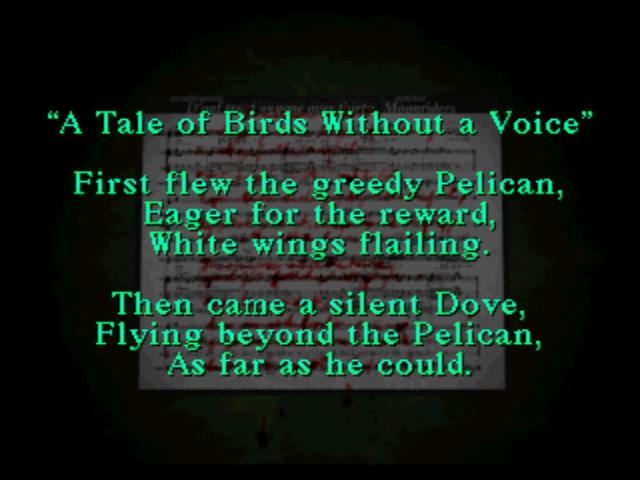
The delivery of the story was the weakest part of the experience for me. While the voice acting does add to the bizarre nature of Silent Hill, the overall acting is not very compellng, including the animations both in-game and pre-rendered. What stuck out the most as boring were long statics shots of completely still characters exchanging stiff dialogue. Maybe it wasn't within the scope of the game, but it feels like more could have been done to make the acting and the camera work with the lines and emotion(?) being delivered. The story itself is pretty dry, though its hard to talk about it without spoiling the relatively little that happens. There also just doesn't seem to be a lot to chew on here. It's easy to ascribe more meaning to the events and monsters of the game in retrospect after playing the two planned sequels, but the story on its own didn't have a lot of interest. Silent Hill 3 deepens these feelings for me as it went much farther with similarly occult themes.
The game kind of slows down towards the end as well. Some of the later structures, while having their own strengths, feel significantly less interesting to navigate while having some sort of obvious scares. The story drags on a bit as well, which fueled my desire to get the game over with. Despite that Silent Hill is a very good introduction to the series and I think it still stands on its own for its great sound and ambient design and feeling the most unrelenting in terms of moment to moment pacing. Its fairly short too so I think its definitely worth checking out.
